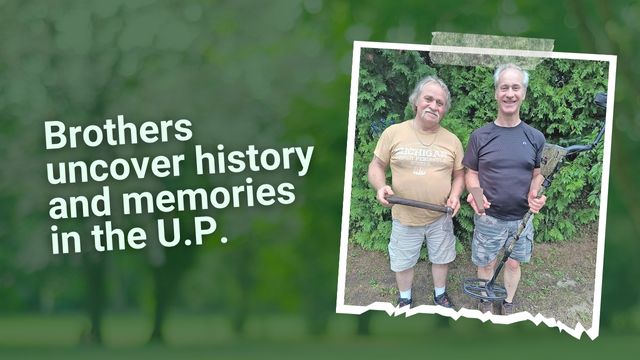By Pete Wurdock
For the past two decades, Newberry residents and brothers Charlie and Dale Lindsay have quietly combed the forests, fields, and forgotten corners of the Upper Peninsula with metal detectors in hand.
Armed with patience, research, and a knack for reading old maps, the brothers seek places where history lingers just beneath the surface. Their finds range from rusted tools and relics of logging camps to coins and long-lost trinkets from early settlers. Each discovery tells a story, but the true treasure, they say, isn’t buried in the ground.
“It’s about being together,” Charlie said. “When we were younger we were busy with kids and family and word and time just slipped away.”
They’ve since realized that what is more valuable than the objects they find underground is the time they’ve shared in the outdoors.
Charlie started it. He was searching for a good hunting spot for his young son, and Dale came along with them with his metal detector in hand. Dale unearthed a couple of interesting items, and it piqued Charlie’s interest. Soon Charlie had his own detector. The brothers were hooked.
They bought basic detectors first, and gradually improved their equipment. “We wanted to get down deeper and deeper to find older things,” Dale said. “In a way, it was like a competition with each of us razzing each other on our explorations.”
“There’s a wide variety of things you can find with a metal detector,” Charlie said. “From recently discarded items all the way back into history.”
The most common items they come across are old beer cans, coins, and junk piles that occasionally render something worth keeping.
Treasure hunting in the U.P. isn’t easy. It often means hiking into dense woods and braving clouds of mosquitoes. The preparation is as important as the hunt itself. The brothers spend hours poring over historical records, plat maps, and family lore to choose their next destination. Their research has led them to abandoned homesteads, overgrown trails, and forgotten logging sites.
There is a storied history of the fur trade in the Eastern UP, and finding axe heads have become more common, some of them dating back hundreds of years. Collectively they’ve found numerous blades from hunters, coins, knives, and arrowheads.
“Dale and I are interested in history, and we’ve found a lot of information through the internet,” Charlie said. “Having some knowledge of geology is also helpful.”
Many of the locations they explore are near modern cottages because they tend to have a history of previous dwellings on or around the same areas.
“At one time the Eastern Upper Peninsula was underwater, so we tend to go where the higher elevations exist,” Charlie said. “The areas with lower elevation tend to have more erosion, which can help you or hurt you, but because of the sediment, it hurts your chances of finding something.”
Side by side, they celebrate each small find, tease one another over false alarms, and share the satisfaction of piecing together bits of U.P. history.
Part of the process is gaining knowledge of the items they find while trying to determine their origin and what they were used for.
“We can learn by them, admire them, and enjoy them. There is a mystery in every adventure because you have no idea what you are going to find,” Charlie said.
Each expedition creates a new memory for the brothers, and that’s become the most important part of their excursions. After 20 years, they’ve built not just a collection of artifacts, but a catalog of memories. And with every trip, they’re reminded that some treasures aren’t found in the ground; they’re found in each other’s company.
“When we first started exploring like this, finding historical items was exciting,” Charlie said. “But now at our age, we know we are running out of time. Doing things like this together and having all these memories over the past 20 years is worth more than anything we might find. Today finding something interesting is the icing on the cake.”











